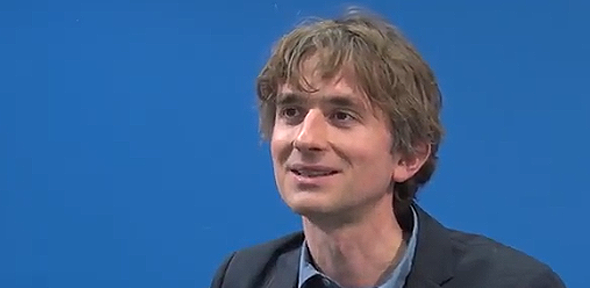
"Cambridge is a great place for mathematics; it has always been," says Emmanuel Breuillard, the newly appointed Sadleirian Professor of Pure Mathematics at DPMMS. "I did a masters degree here, so I had some idea of what Cambridge would be like and I was keen on coming back. When this opportunity arose I jumped on it."
Looking at the line of Sadleirian Professors that came before him, it's easy to understand Breuillard's enthusiasm. The first Sadleirian Professor, appointed in 1863 with an endowment left by Lady Mary Sadleir in 1701, was Arthur Cayley, a towering figure of nineteenth century mathematics who'll be familiar to many through the variety of mathematical objects and results that carry his name: from Cayley's theorem to the Cayley Graph. Other Sadleirian Professors have included the number theorists G.H. Hardy and Louis Mordell, and, more recently, John Coates.
One great thing about DPMMS is that it's very diverse. It's great to be able to talk to a probabilist in the morning, a combinatorialist in the afternoon, and a geometer the next day. Emmanuel Breuillard
"Both the history of the place and the [current] conditions [attracted me to the Sadleirian Professorship]," says Breuillard. "One great thing about DPMMS is that it's very diverse. This is probably also due to the fact that the undergraduates are very good; it's a very good school to learn mathematics. So the department has to be very good in every subject. And at the same time it's a small department. For me it's great to be able to talk to a probabilist in the morning, a combinatorialist in the afternoon, and maybe to a geometer the next day."
Building bridges
According to the 19th century statute Breuillard's duty will be "to explain and teach the principles of pure mathematics, and to apply himself to the advancement of that science." For this he is perfectly placed. "I'm a pure mathematician, but I'm not exactly specialised in any particular field of mathematics. I like to connect fields together," he says. "My areas of expertise are group theory and geometry, but groups are central objects in mathematics, they have connections to many different fields, be it probability theory, geometry or number theory."
Connecting different fields of mathematics can lead to fruitful results. Breuillard has applied model theory, a branch of mathematics that explores abstract mathematical structures from the point of view of logic, to problems in combinatorics. In turn, ideas from combinatorics have had a strong influence on group theory, which has enabled group theorists to overcome obstacles that previously seemed insurmountable.
In the context of building bridges between fields, Breuillard also singles out an area of maths in which Cambridge has been particularly successful: additive number theory. While multiplication, as an operation, is amenable to number theory — every integer can be expressed as a product of primes in a unique way — addition proves a lot more tricky. A famous question from additive number theory is the Goldbach Conjecture, which states that every even integer greater than 2 is a sum of two primes: an innocuous-looking statement which, like so many problems in number theory, remains unproven.
Arithmetic progressions
Breuillard is interested in another hot topic in additive number theory, in which Cambridge mathematicians have excelled. It concerns sequences of integers in which consecutive entries are always the same distance apart, such as 2, 4, 6, 8 or 1, 4, 7, 10, 13, 16. These are called arithmetic progressions. Given a set of integers, such as the much-loved set of prime numbers, you might ask what, if any, arithmetic progressions it contains. It's easy to see that the primes contain at least one arithmetic progression of length three — 3, 5, 7 — but do they contain longer ones?
The answer was given in 2004 by mathematician Ben Green, then at Cambridge, who together with Terence Tao proved that the primes contain arithmetic progressions of any length. Green's PhD supervisor Tim Gowers, Professor of Mathematics at DPMMS and winner of a 1998 Fields Medal, has also done important work in the area of arithmetic progressions. For example, he has identified conditions a set of integers must satisfy so that we can be sure it contains arithmetic progressions of a given length.
The underlying objects of additive number theory are the integers, which form a group under addition (as long as you allow the negative integers into the mix). The field of combinatorics also often deals with groups, but these can be of a more general nature, in particular, they need not be commutative (that is, for two group elements a and b, and writing + for the group operation, we do not necessarily have a+b=b+a). But, as Breuillard showed in work with Gowers, Green and Tao, it turns out that techniques from additive number theory have proved hugely successful in this context too.
"People realised in the first decade of the 21st century that many of the ideas and many of the tools that have been developed over the years to understand progressions [...] can be applied to understand combinatorics in non-commutative groups and to solve conjectures in group theory," says Breuillard. "That's an example of a transfer of knowledge, abilities and techniques between two completely different fields that previously didn't talk to each other at all."
According to the European Mathematical Society (EMS), Breuillard's ability to use " a wealth of methods from very different areas of mathematics [...] has already made a long lasting impact on combinatorics, group theory, number theory and beyond." In recognition the EMS awarded him one of its prestigious prizes at the European Congress of Mathematics in 2012. DPMMS is proud to welcome such an accomplished builder of bridges to this famous post.
